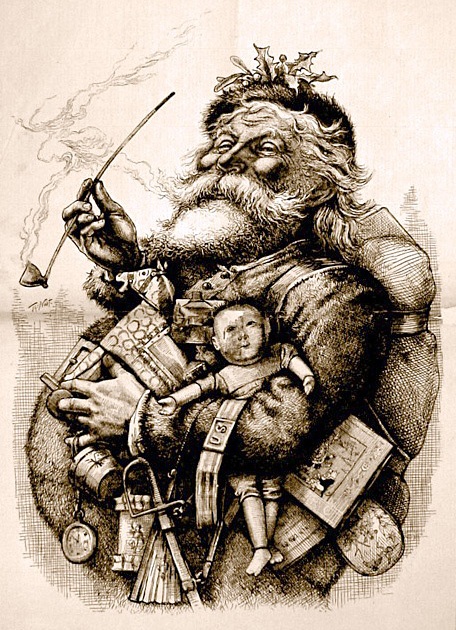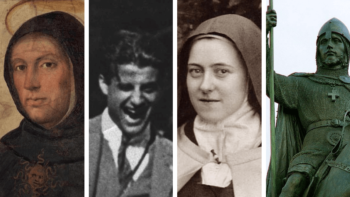
Most Catholics can rattle off a list of who they believe are the ten most popular saints. The lists would vary, but would likely contain many of the same names.
There are some saints, however, who are so famous that they are known around the world—not only to Catholics but to people of all beliefs or none.
This can be an example of how holiness attracts people, even if they don’t understand why. It reminds me of Matthew 5:16, which says, “Let your light so shine before men, that they may see your good works and give glory to your Father who is in heaven.”
The bad news is that this widespread saintly fame can also cause confusion. Many famous saints are misunderstood by popular secular culture, usually because they are associated with causes that are wildly misunderstood. Such popular confusion has led to muddled understandings of these holy men and women.
What to do?
Well, we can always learn what the truth is, and avoid the misunderstandings.
Who are some of the most misunderstood saints in history? I’ve picked three, for the sake of this article.
Let’s begin with the man who is, arguably, the most misunderstood saint of all time.
1. St. Francis of Assisi
Popular portrayal: tree-hugging, world-peace-proclaiming saint with a pigeon on his shoulder
Reality: a man who abandoned a life of indulgence to live a life on fire with love for Christ and His cross—also the first known saint to receive the stigmata
It is devastating how widely misunderstood St. Francis is.
Clergy and laymen alike perpetuate the false sentimental picture of him: a nice, soft, harmless environmentalist who strokes animals and coos a message of sentimental love and peace to the world. They would be shocked if they read an in-depth biography of St. Francis…or encountered his description of a soul that goes to hell after death.
The real Francis was bold, courageous, self-sacrificing, and uncompromising. His love for God and truth was passionate and demanding. He was more real, more alive, than the typical image that is usually presented. He had a magnetic effect on those who met him.
He challenged others, but was hardest on himself. He was penitential and deeply ascetic.
He was known to spend entire nights in prayer, so lost in awe of God that the only words that came from him were “Deus meus et omnia,” which means “My God and my all.”
He had no false understanding of ecumenism. He knew that all souls needed to encounter Christ and be transformed in His Church. He traveled to meet the caliph—a chief Muslim civil and religious ruler—and preach Christ to him. It is uncertain whether he was successful, but it may be safe to say that Francis is the only man to have survived such an attempt.
These few stories of St. Francis merely skim the surface of his incredible life. Yet, alas! all people think of when they hear his name is “Animals!”
It is true, of course, that Francis saw animals as the handiwork of an all-powerful Creator; but it’s important to remember that he loved animals in a very different way than the world does. He can teach us to have a balanced love of animals and to always put people before pets.
In the book A Priest Answers 27 Questions You Never Thought to Ask, Father Michael Kerper writes:
We learn about the approach of Saint Francis [to animals] primarily from Saint Bonaventure…the greatest of all Franciscan theologians…Saint Bonaventure wrote that Saint Francis loved animals mainly because they reminded him of God, their true origin, not because of cuteness or friendliness toward humans.
For Saint Francis, animals were ‘sacramentals,’ whose mere existence innocently and unconsciously pointed toward God.
…Whenever [Francis] saw a little lamb he immediately thought of Christ, the Lamb of God sacrificed for the salvation of all humanity. Seeing a lamb became an inspiration for prayer and contemplation. His love for lambs was so intense that Saint Francis once cursed a vicious old sow who killed a newborn lamb. After grieving for the dead lamb, Saint Francis said, ‘Alas, brother lamb, innocent animal, you represent Christ to me. A curse on that impious beast that killed you; may no man or beast ever eat of her!’ Saint Bonaventure reported that the sow died three days later after an excruciating illness. Even Saint Francis had favorites—and disliked nasty animals.
Although the patron saint of pets, Saint Francis never kept animals as personal possessions; his strict vow of poverty precluded ownership of anything, including pets…people often presented animals to Saint Francis as gifts…[but] after spending some time with them, Saint Francis inevitably encouraged them to return to their natural habitat…In keeping with authentic Franciscan spirituality…we must always respect and cherish animals…as wondrous reflections of God’s loving and creative power. But we must also recognize that our responsibility to human beings, who are created in God’s image and likeness, always trumps our concern for any animals, who are only faint reflections of God’s glory.
St. Francis knew that we ought to care for creation as a gift from God that can aid us in our journey to Eternal Life—but he also knew that the wellbeing of our souls and their eternal destination (heaven or hell) always comes first.
Certain Franciscan nuns and brothers refer to the sentimental portrayals of Saint Francis as “the bird-bath St. Francis.” They know that there is so much more to him than a concern for the environment that is separated from Christ and His Cross.
No doubt you’re familiar with the basics of Saint Francis’s life, but if you’re interested in learning more, this article is very thorough.
2. St. Nicholas
Popular portrayal: jolly ol’ St. Nick (with Mrs. Claus and a company of elves)

Reality: the Bishop of Myra, a holy, courageous man who was reputed to raise people from the dead, and who worked so many miracles that he is called “Wonder-Worker”

The popular idea of Santa Claus does not exist without reason. The Santa figure we know today was derived from a real man: St. Nicholas of Myra.
He was born March 15th, in the year 270, and died December 6th, 343. We don’t know as much about him as we’d like, but we do have some impressive facts for a man who lived so long ago. We know, for example, from the examination of what are believed to be his skeletal remains that he was 5’6″ tall and had a broken nose. (We don’t know why his nose was broken.)
Since he was a bishop and a celibate, there is no Mrs. Claus.
It is believed that Nicholas was one of the bishops present at the Council of Nicea in 325 A.D., from which the Nicene Creed takes its name.
There’s quite a story from that council: apparently Nicholas was so grieved by Arius’s heretical views on Jesus Christ that he walked up to Arius and slapped his face!

The other bishops at the council, appalled by the scene, confiscated his bishop’s vestments and placed him in prison.
Jesus and His Blessed Mother came to visit Nicholas in his prison cell. When the guards came in later, they found him unchained, wearing his bishop’s garb (returned to him by Our Lady) and quietly reading the Scriptures.
There are amazing traditions regarding Nicholas’s life that have been consistently told over the years.
The best-known story was his generosity to a man whose three daughters could not afford the dowry needed to marry. When Nicholas heard of this, he tried to secretly leave three bags of gold at their home, so that the women could have a dowry and not be forced into prostitution by their poverty. Their father discovered his final attempt to leave the gold, and sought to praise Nicholas. But the saint humbly replied that all the glory should go to God.
There is so much more to learn about him: his love for sailors and the miracles he worked for them, his love for children, and more. If you want to further discover the real St. Nicholas, you might want to peruse this site.
If you want to help children discover the real meaning of Christmas, the Kneeling Santa figures are a beautiful way to teach kids to keep their focus on Christ!
3. St. Patrick of Ireland
Popular portrayal: Irish figurehead, whose feast day is celebrated with beer, parades, and green-everything
Reality: a Romano-British bishop and missionary who brought Christ to the Irish people that enslaved him

Like St. Nicholas, the real St. Patrick was born many years ago: circa 385. He died sometime between the years 462 and 493.
Known as the Apostle of Ireland, we still have his writings today. His autobiography can be found in the Confession of St. Patrick.
“I am Patrick, yes a sinner and indeed untaught; yet I am established here in Ireland where I profess myself bishop. I am certain in my heart that ‘all that I am,’ I have received from God. So I live among barbarous tribes, a stranger and exile for the love of God…I speak out too for love of my neighbors who are my only sons; for them I gave up my home country, my parents and even pushing my own life to the brink of death. If I have any worth, it is to live my life for God so as to teach these peoples; even though some of them still look down on me.”
St. Patrick
His life is better than the movies. When he was sixteen, he was kidnapped by Irish pirates from Britain, his native country. Made a slave by the pagan Irish, he worked as a shepherd for six years before escaping and returning to Britain.
Apparently he was not particularly devout before his captivity; but during that time, his spiritual life grew, as did his dependence on God.
After Patrick’s return home, he continued to study the Christian faith. He had a vision a few years after his return, of which he writes:
“I saw a man coming, as it were from Ireland. His name was Victoricus, and he carried many letters, and he gave me one of them. I read the heading: ‘The Voice of the Irish’. As I began the letter, I imagined in that moment that I heard the voice of those very people who were near the wood of Foclut, which is beside the western sea—and they cried out, as with one voice: ‘We appeal to you, holy servant boy, to come and walk among us.'”
St. Patrick
Responding to the vision with faith and extraordinary courage, Patrick returned to Ireland as a missionary after being ordained a priest. He then spent all of his strength, and the rest of his life, bringing Christ to the pagan Irish. He suffered numerous hardships and dangers for the Gospel, just like St. Paul.
“I cannot keep silent, nor would it be proper, so many favours and graces has the Lord deigned to bestow on me in the land of my captivity.”
St. Patrick
Despite the obstacles, he saw the Catholic faith take root in the hearts of the Irish people. Many of the men and women became monks and nuns; the sons of Irish chieftains became devout Christians. Patrick writes:
“Never before did they know of God except to serve idols and unclean things. But now, they have become the people of the Lord, and are called children of God. The sons and daughters of the leaders of the Irish are seen to be monks and virgins of Christ!”
St. Patrick is believed to have died March 17th, which is why the Catholic Church celebrates his feast on that day.
Truth Is Stranger Than Fiction…
The best stories are the real ones, don’t you think?
Salvation History culminated in the most amazing true story of all: the Son of God taking human flesh to rescue His bride, the Church and all souls, from eternal death.
It is only unexciting to us because it is so familiar. We’ve heard it before, and therefore might feel that it’s not the most astounding event to have taken place. But it really is a more crazy story than anything we could have invented on our own.
In a similar way, the lives of the saints don’t need a thousand interpretations or embellishment. The saints themselves certainly don’t want to be misunderstood!
Whenever you have a question about any saint and the things said about them, do some research. It might take a little sifting to find reliable sources online, but there’s a wealth of solid information out there.
Perhaps, someday, there will be fewer misunderstandings of the saints we love so much.
What other saints do you think are commonly misunderstood or misrepresented?
If you are interested in imitating the saints more closely, and developing virtue in your personal life, you will love our series Heroic Virtue. Sign up today and let the saints guide you to an extraordinary life.








